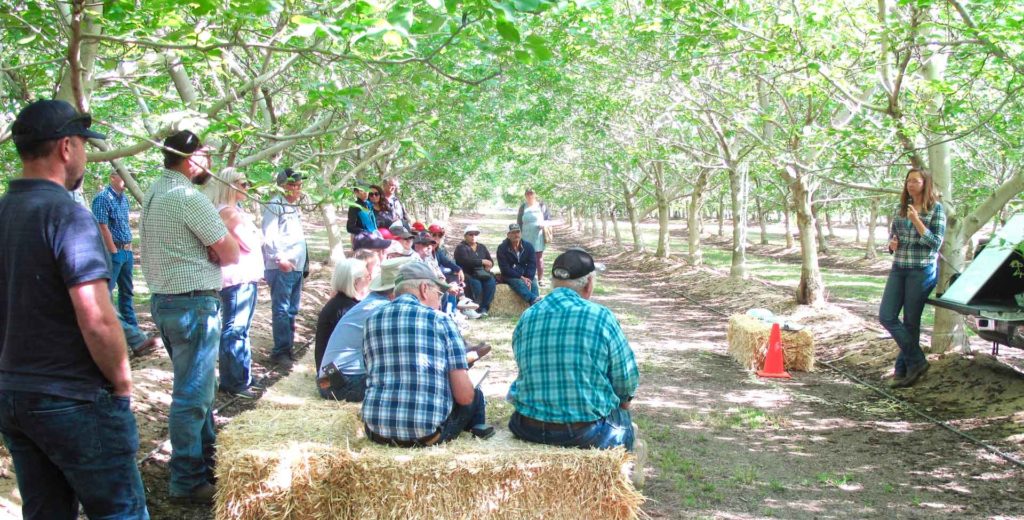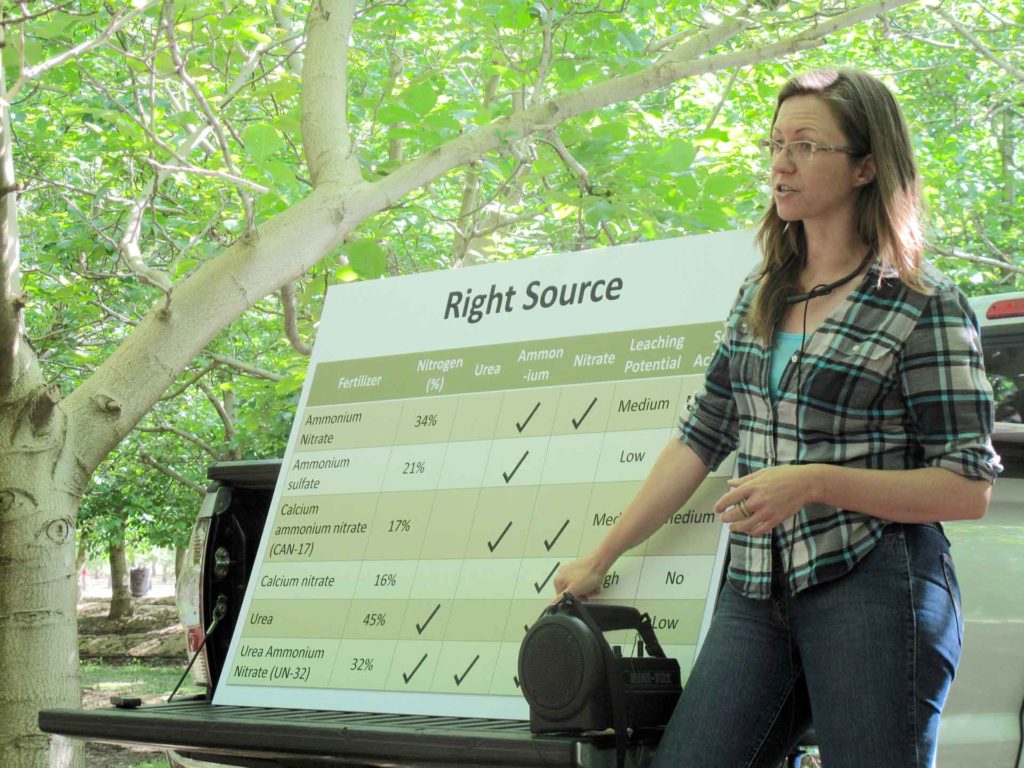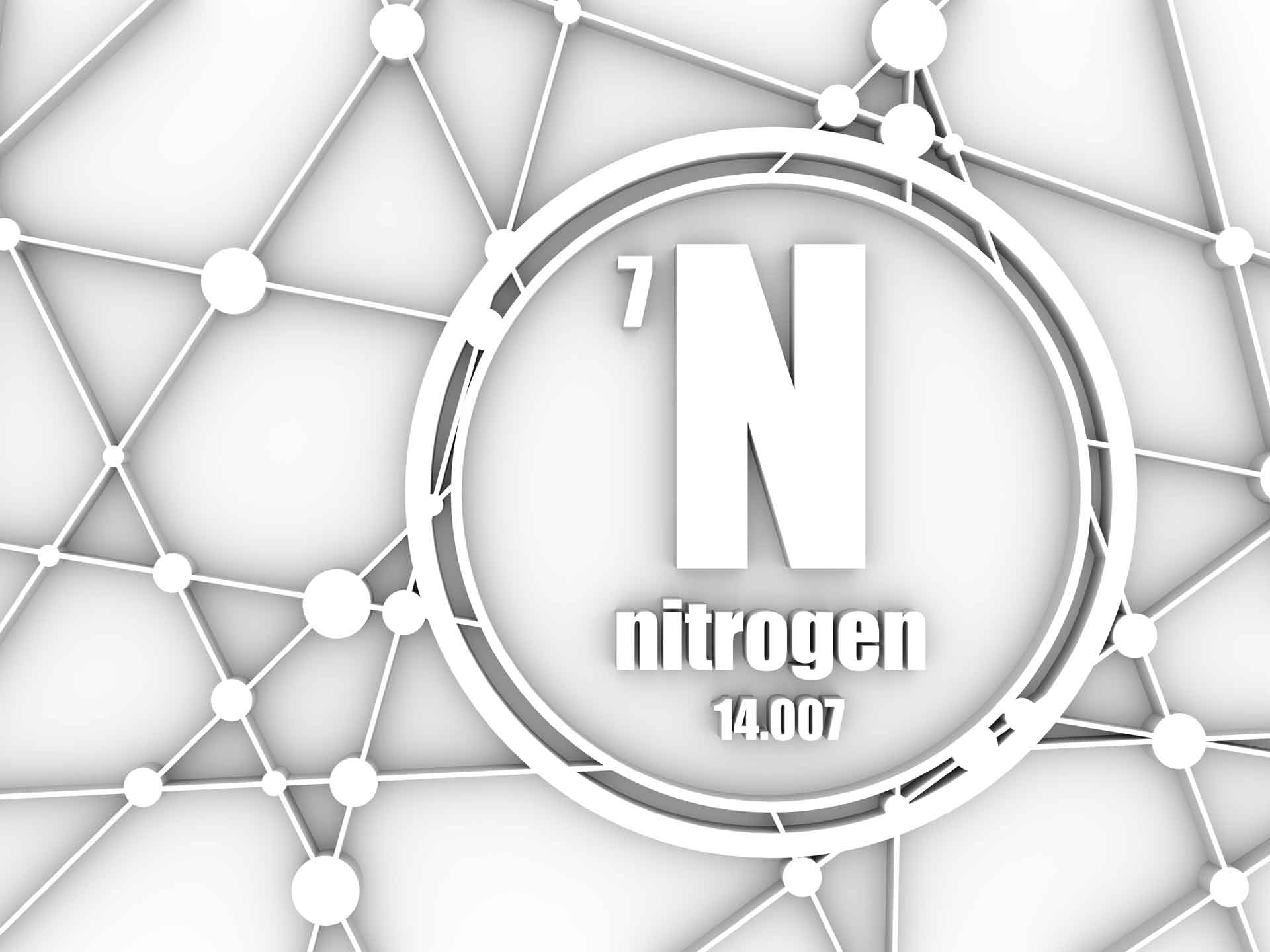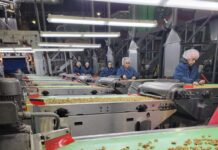To know how to correctly use nitrogen in walnut orchards, you first have to know some of the basic principals of nitrogen, according to Katherine Jarvis-Shean, University of California Cooperative Extension area orchard systems adviser for Sacramento, Solano, and Yolo counties. Jarvis-Shean shared this information during the Nickels Soil Lab Annual Field Day in her presentation—Nitrogen in Walnuts: What, When, Where and How Much?
Nitrogen Principals
Jarvis-Shean said growers have a few different forms of nitrogen as options of use in their agriculture systems.
“Nitrogen is one part of soil organic matter, one part of urea, as in ammonium, and then nitrate,” she explained. “So those are ways we encounter nitrogen in our soils when we are trying to get it up into our plants.”
Unless a grower is in an organic system, soil organic matter is not a huge source of nitrogen for most ag systems. In those circumstance, the nitrogen input sources from soil organic matter must come through nitrogen-based cover crops or manure compost.
“It is like a savings account from which you get a small dividend every month, it is a slow leak out of nitrogen from soil organic matter, but it is never a big wallop,” Jarvis-Shean said.
Urea is a neutral that moves through the soil with water, she added. Urea doesn’t stick in the soil profile, but it does change to ammonium in a matter of days after it has been applied because of micro activity in the soil.
“Think of urea as acting like ammonium, as it changes to ammonium pretty quickly,” Jarvis-Shean said. “This leaves us with ammonium and nitrate, our two big hitters in our nitrogen system.”
She explained that ammonium is positively charged, and while this doesn’t seem to be a big deal, it is.
“Because the surface of the soil is negatively charged, so ammonium will stick in the soil, which we like, as that means it doesn’t leach out of the soil system and the roots can take up nitrogen in the form of ammonium,” she stated.
Nitrate, on the other hand, is negatively charged, which means it wants to stay away from the negatively charged soil, so it doesn’t want to stick.
“This keeps it moving through the soil system when water is applied,” Jarvis-Shean said. “Nitrate leaches out very easily through the root zone when putting water on top of it, and moving it through the soil and root zone.”
Nitrate is easily taken up by the roots so we like that part of it, she added, but it has this liability of being leachable.
“So you might say, let’s just get around all these leaching problems by just applying ammonium—unfortunately it is not that easy, because ammonium will be munched on by microbes and turn into nitrate— we call it nitrification,” Jarvis-Shean advised. “And that, in California’s soil systems, happens pretty quickly. So with the temperatures we have in the growing season, about half the ammonium applied will turn into nitrate in about two weeks if it hasn’t been taken up by the tree.
That’s a pretty quick turn around, so we can’t put a lot of nitrogen on in the form of ammonium in the beginning of the growing season and hope it will get us through the whole growing season because a lot of that can turn into nitrate and leach out of the root zone.”

The Four R’s of Nitrogen Management
With the basic principals of nitrogen in hand, Jarvis-Shean talked about the four R’s of nitrogen management in walnuts—What, When, Where and How Much or otherwise known as “the right time, the right place, the right rate, and the right source.”
She said:
- Right rate is about matching the overall seasonal demand with your overall season’s nitrogen application.
- Right time is keeping in mind that trees, plants in general, are best at taking up nitrogen when they need it. It uses some energy for the plant to take up nitrogen so they aren’t going to do it unless they have a use for it. The right time is getting the nitrogen on when the tree demands it.
- Right place is remembering its the roots that take up nitrogen, so thinking about where those roots are is key, and keeping the nitrogen in the root zone.
- Right source is a little less straight forward. There is no one perfect answer for the whole Sacramento Valley, but there are different options.
Right Rate
How much nitrogen is in every ton of nuts?—is another way of asking the question of right rate, Jarvis-Shean shared.
Growers need to think about matching supply, what they are putting in, with the demand—this is on a mature tree that isn’t growing any more but mostly just growing and harvesting nuts.
How do you figure this out, what is the demand?
Jarvis-Shean referred to research conducted in “a big three year project, where we were in two variety of orchards, Tulare and Chandler in Hanford, Linden and in Red Bluff, so we were covering the whole valley with different growing conditions and different growers. The team sampled at the end of the growing season how much nitrogen was in the walnuts in the test orchards.”
The research team found on average 29 pounds of nitrogen for every ton of in-shell nuts, she said.
Right now the nitrogen number for irrigated lands per every ton of nuts is about 35 pounds or less, according to Jarvis-Shean.
“Everyone has been tightening their nitrogen belt already, and it’s going to get a little tighter as we believe that number is going to be less in the end,” she added. “We haven’t published this number yet because we are triple checking the numbers to make sure they are right before we suggest you put on even less nitrogen, but we are pretty sure our numbers are true.”
So, in summary, Jarvis-Shean said, a minimum of 29 pounds nitrogen for in-shell nuts, is what you need to meet the demand of growing a crop. Taking into account not just the synthetic nitrogen added, but also nitrogen in the water and anything from cover crops and manures.
Right Time
The right timing is critical in supplying nitrogen when trees need it the most. It also decreases risk of nitrate leaching below the root zone and into the environment.
Growers have traditionally made two applications of nitrogen in May and July. However, Jarvis-Shean said, during their three year study, researchers went out to the test orchards every month to check how much nitrogen is in the walnut this month, compared to how much was in the walnut the previous month and found an even application over a four month period to be more productive.
Supplying nitrogen to trees needs to take place in May, June, July, and August as those are the months researchers found the trees have the greatest demand, she added.
“We found a pretty even demand through those months,” Jarvis-Shean said. “The takeaway here is the right rate of nitrogen applied evenly over those months.”
Researchers found in April, nitrogen in the walnut tree comes from storage in the trunk and in the roots. “So, if you are putting nitrogen on in April, it is not going to be taken up, it is going to just sit there, vulnerable to leaching from rain water and irrigation,” she added.
Right Place
A grower can get walnut roots down to 10 feet, however, Jarvis-Shean said, the vast majority of roots will be in the top three feet of the root zone.
“So, researchers overall found a lot of roots in the top two feet, some in the top three feet and then it starts to peter-out,” she explained. “When we decide where we want our nitrogen to be, it is in these top three feet of the soil, which, practically speaking is the root zone.”
The right place is as much an irrigation question, as it is a fertilizer management question, because growers want to be irrigating in such a manner as to keep the water in the top three feet, according to Jarvis-Shean.
Whether that is accomplished by looking at evapotranspiration (ET) scheduling, looking at emails provided by farm advisors are sharing now that show a generic walnut water use in any given week, or use soil moisture probes telling when the water has hit three feet—there are many ways to approach this goal, but try to keep in mind, she said, irrigating past three feet is pushing nitrogen past three feet and it is wasted.

Right Source
Javis-Shean said the right source is the trickiest one of the four R’s.
“There is no one right answer to this question for every orchard across the board,” she added. “Just remember, different fertilizer sources, such as ammonium nitrate, ammonium sulfate, calcium ammonium nitrate, calcium nitrate, urea, and urea ammonium nitrate—some have nitrate, some have ammonium, some have urea.”
Ammonium and urea are not as vulnerable to leaching, while nitrate has high leaching potential.
“You might choose a fertilizer for a lot of different reasons,” Jarvis-Shean said, “maybe you’re trying to certify your soil at the same time. Maybe you need a source of calcium, but keep in mind each of these sources come with their own leaching story, their own leaching baggage.”
If applying a calcium nitrate, she explained, that is all nitrate which is highly susceptible to leaching, so keep that in mind and divide it as much as possible over the course of the growing season and really focus on keeping the water in the top three feet of the root zone.
As for ammonium sulfate application, there is no nitrate in that, so growers have a little more wiggle room in water management and it can be applied four times a year instead of six to eight.
Summary
Jarvis-Shean summed up her information with the reminders of a minimum of 29 pounds of nitrogen per ton of walnuts, applied evenly over the course of the growing season in the top three feet of the soil, and there is no one right source of nitrogen application for all growers, but think about the leaching potential of any source of fertilizer used.











